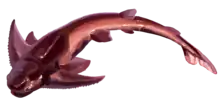Ailuracantha
Ailuracantha is a dubious extinct placoderm genus from the actinolepidae family. It was discovered in a layer of the Senni Beds near the Black Mountains in Wales, and it is represented by only one species: Ailuracantha dorsifelis.[1]
| Ailuracantha Temporal range: Early Devonian | |
|---|---|
 | |
| Artist's reconstruction of A. dorsofelis | |
| Scientific classification | |
| Domain: | Eukaryota |
| Kingdom: | Animalia |
| Phylum: | Chordata |
| Class: | †Placodermi |
| Order: | †Arthrodira |
| Family: | †Actinolepidae |
| Genus: | †Ailuracantha |
| Species: | †A. dorsifelis |
| Binomial name | |
| †Ailuracantha dorsifelis White, 1969 | |
Etymology
The generic name Ailuracantha comes from the Greek αἴλουρος (aílouros), meaning "cat", and ἄκανθος (akanthos), meaning "spine" or "thorn"; the type species dorsifelis comes from the Latin dorsum, meaning "back," and felis, also meaning "cat." Both specific and generic names are in reference to The Cat’s Back, a spur of the Black Mountains and the locality the holotype was recovered from.
Paleobiology
Ailuracantha is relatively standard for an actinolepid, possessing a small, slightly dorsoventrally flattened body with two proportionally large spines on its thoracic shield. Unlike other members of this taxonomic group, its pectoral spines possess a narrow under surface and deep mesial surface, possibly suggesting greater mobility in them than observed in its relatives. Its frontal region is ornamented with small, oval-shaped tubercles, which are extremely fine on its ventral side.
Ailuracantha was a freshwater fish that lived in floodplain regions. It was probably a benthopelagic predator that fed on small, soft-bodied invertebrates.
References
- WHITE, ERROL I. (1 September 1969). "The deepest vertebrate fossil and other arctolepid fishes*". Biological Journal of the Linnean Society. 1 (3): 293–310. doi:10.1111/j.1095-8312.1969.tb00122.x. Retrieved 30 July 2018.
External links






